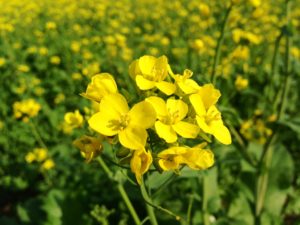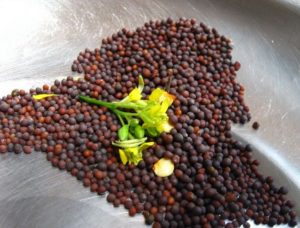Types of Mustard
1. Rai (Indian Mustard)
1. Botanical name is Brassica juncea.
2. It is locally known as mohair or rai.
3. The plant is tall, erect and much branched.
4. Fruits are slender.
5. The seeds are small and reddish brown in colour.
6. In India about 70% area is under this type of mustard.
2. Sarson:
1. Botanical name is Brassica campestric.
2. The fruits are thicker than those of rai.
3. The seeds are yellow or brown.
4. The seed coat is thin.
3. Toria or rape seed:
1. Botanical name is Brassica napus.
2. Plants are more vigorous and hardy.
3. The seeds are reddish.
4. It is commonly found in Punjab.
4. Taramira of Seoba or tara:
1. Botanical name is Eruca sativa.
2. It is of African origin.
3. The stem is and covered with stiff hair solid .
4. The fruit are shorter and stout.
5. The seeds are in a double row in each compartment of the fruit.
Introduction of Mustard: – Mustard belongs to the family of “Crucferae” and popularly used in Indian cooking. India is number one in production mustard. Mustard gives edible oil which is used as cooking in India. Mustard seed is used as vegetable. It can be used as oil cake to feed cattle.
Major mustard production states in India: – Rajasthan, Gujarat, Uttar-Pradesh, West Bengal, Haryana, Madhya Pradesh and Assam are major mustard seeds producing states in India.
Health benefits of mustard: – Some of the health benefits of mustard are given below.
• Health in controlling symptoms of asthma.
• Prevents from gastrointestinal cancer.
• Helps in weight loss.
• Helps in relieving arthritic & muscle pain.
• Help in slow ageing (Anti Ageing).
• Helps in lowering cholesterol & stimulates hair growth.
Local names of Mustard in India: – Rai, Banarasi Rai, Kale sarson (Hindi), Rai (Gujarati), Sasave (Kannada), Assue, Sorisa (Kashmiri), Avalu (Telugu), Kadugo (Tamil), Kaduku (Malayalm), Rai, Banarasi rai, kale sarson (Punjabi).
Commercial hybrid varieties of Mustard in India: – Pusa Agrani (SEI-2), Kranti, Pusa Vijay (NPJ-93), Pusa Mustard 27 (EI-17), Pusa karishma (LES-39), Sita, Pusa Mahak (JD-6), Pusa Mustard 21 (LES 1 27), Pusa Mustard 22 (LET-17), NPJ-112 (Pusa Mustard 25), Varuna, Krishna, Pusa Mustard-24 (LET-18), Pusa Tarak (EJ-13), Pusa Mustard 26 (NPJ-113), Pusa Mustard 28 (NPJ -124), Punjab Bold.
Climate requirements for Mustard farming: – Mustard is grown in subtropical climate. Mustard thrives well in dry and cool climate, therefore mustard mostly grown as Rabi season crop. Mustard crop requires the temperatures between 10°C to 25°C. Mustard crop is grown in the areas receiving 625-1000mm yearly rainfall. This crop does not tolerate frost, so it requires clear sky with frost free conditions.
Soil Requirements for mustard farming: – Mustard can be grown in wide varieties of soils that ranges from light to heavy loamy soils. Medium to deep soils with good drainage is best suitable for mustard cultivation. Soils ideal ph range for Mustard is 6.0 to 7.5. Make sure to carry out a soil test to find out the soil properties like soil type, strength and nutritious levels.
Preparation of land in Mustard farming: – 1 to 2 ploughings and two harrowing should be given as part of field preparation. For second crop cultivation, field should be prepared by .giving 2 crosswise harrowing after kharif crop.
Seed Treatment in Mustard farming: – Seeds should be treated with Thiram at 3 grams per kg of mustard seed to protect the plants from seed diseases.
Sowing methods and seed rate in Mustard farming: – Mustard usually had sown in Sep-Oct months. If mustard crop as pure one, it should be sown by drilling method or if this crop as mixed crop, seeds should be sown by broadcasting or drilling method. Mix the seeds with fine sand for uniform spacing. For better germination, seeds should be sown maximum of 6 cm depth in the soil. Make sure there is enough moisture present in the soil when seeds are sown.
 In pure mustard crop seed rate could be about 4-6 kg per hectare.
In pure mustard crop seed rate could be about 4-6 kg per hectare.
In mixed crop seed rate could be about 2-3 kg per hectare.
Spacing in Mustard Farming: – Spacing of plants should be about 45cm X 20cm.
Mustard as mixed crop: – Mustard can be grown as mixed crop with gram, wheat & lentils. If you are planning mustard as an inter crop, one line of mustard and four lines of gram or one line of mustard and nine lines of wheat should be sown.
Manures and fertilization in Mustard farming: – 7 to 12 tons of Farm yard manure (FYM) per hectare should be added as part of the field preparation. 20 to 25 kg P205 and 30 to 35 kg N per hectare should be applied in rain fed condition at the time of sowing. 40 to 45 kg N, 30 to 35 kg P205 and 20 to 25 kg K2O per hectare should be applied below the seed at sowing time of irrigated crop. After 1 fmonth of sowing, 20 to 25 kg N per hectare should be applied as top dressing.
Irrigation in Mustard farming: – Pre-soaking irrigations should be given before sowing the seeds. 3 irrigation should be applied @ 4 weeks interval after sowing the seeds.
Weed control/Inter culture operations in Mustard farming: – 2 to 3 weeding & 2 hoeing should be given @ 2 weeks interval. Thinning should be done after 2 weeks time interval (in case of pure mustard crop). In cased of mixed crop, mustard crop receives from the inter cultivation given to main crop.
Harvesting of Mustard: – Harvesting should be carried out as soon as the pods begin to turn yellow color & seed becomes hard. The mustard crop matures in about 110 .to 140 days. Harvesting should be done in early morning hours to avoid any shattering of seed. Use sickle to cut the crop close to the ground.
Post harvesting tasks in Mustard farming: – Harvested mustard plants should be tied into bundles, keep them in sun for 5 to 6 days to dry. Threshing can be carried out by beating the mustard plants with stick. Winnowing is done to separate the grain form husk.
Yield of Mustard: – An average yield of 400 kg per hectare can be expected. Under good variety and management actives, yield can be about 1000 kg per hectare.
